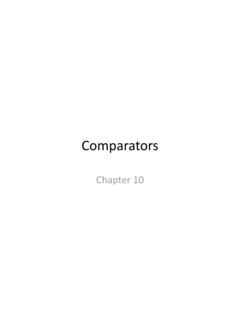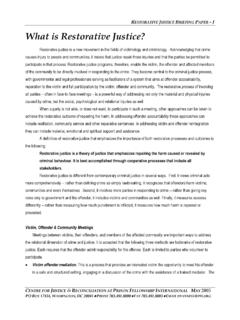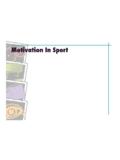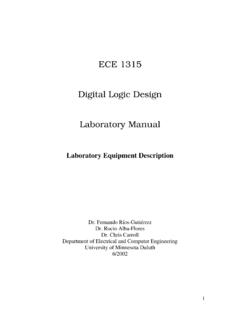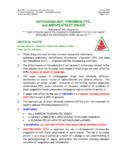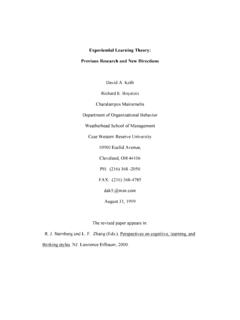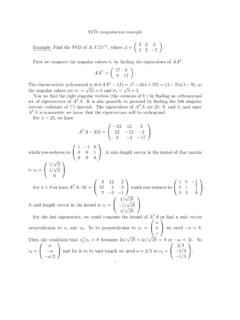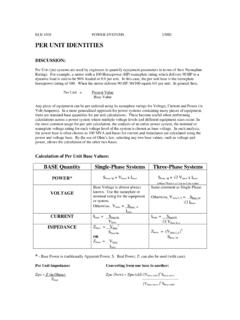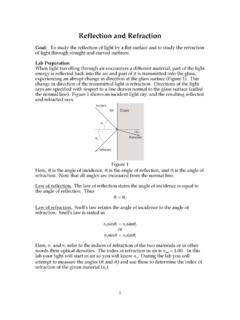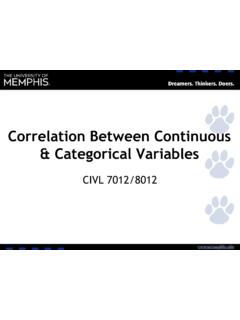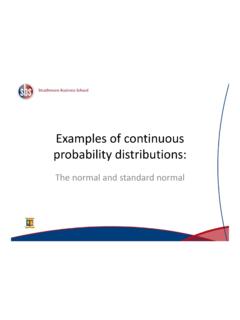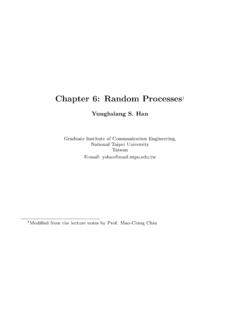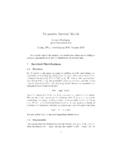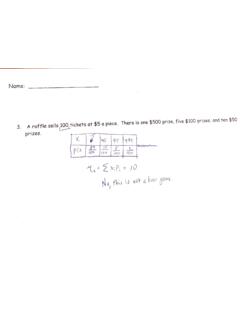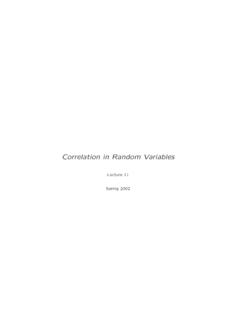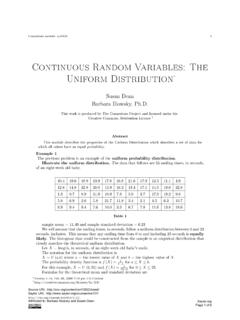Transcription of 3.1 Concept of a Random Variable
1 CHAPTER3 Random VARIABLES AND PROBABILITY Concept of a Random VariableRandom VariableArandom variableis a function that associates a realnumber with each element in the sample other words, a Random Variable is a functionX:S!R,whereSis the sample space of the randomexperiment under convention, we use a capital letter, sayX,to denote a Random Variable , and use the correspondinglower-case letterxto denote the realization (values) ofthe Random (Coin).Consider the Random experi-ment of tossing a coin three times and observing the re-sult (a Head or a Tail) for each toss. LetXdenote thetotal number of heads obtained in the three tosses of thecoin.(a)Construct a table that shows the values of the ran-dom variableXfor each possible outcome of therandom experiment.(b)Identify the event{X 1}in the difference between the number of headsobtained and the number of tails obtained.
2 (c)Construct a table showing the value ofYfor eachpossible outcome.(d)Identify the event{Y=0}in that you play a certain lotteryby buying one ticket per week. LetWbe the number ofweeks until you win a prize.(a)IsWa Random Variable ? Brief explain.(b)Identify the following events in words: (i){W>1}, (ii){W 10}, and (iii){15 W<20} major metropolitan newspaper askedwhether the paper should increase its coverage of localnews. LetXdenote the proportion of readers who wouldlike more coverage of local news. IsXa Random vari-able? What does it mean by saying <x< the survival time for theprostate cancer patients in a local hospital. Explain whyTis a Random Random VariableIf a sample space contains a finite number of possibil-ities or an unending sequence with as many elementsas there are whole numbers (countable), it is called adiscretesample space.
3 A Random Variable is called adiscrete Random variableif its set of possible outcomesis Random VariableIf a sample space contains an infinite number of pos-sibilities equal to the number of points on a line seg-ment, it is called acontinuoussample space. Whena Random Variable can take on values on a continuousscale, it is called acontinuous Random the Random variables in theabove examples to be discrete or Discrete Probability DistributionsThe probability distribution of a discrete Random vari-ableXlists the values and their ofXx1x2x3 xkProbabilityp1p2p3 pkwhere0 pi 1andp1+p2+ +pk=110 Chapter 3. Random Variables and Probability the value ofkso that thefunctionf(x)=k x2+1 forx=0,1,3,5 can be a legit-imate probability distribution of a discrete Random Mass Function (PMF)The set of ordered pairs(x,f(x))is a probability func-tion,probability mass function, or probability distri-bution of the discrete Random variableXif, for eachpossible outcomex,i).
4 F(x) 0,ii). xf(x)=1,iii).P(X=x)=f(x). continuous Probability Distributions87xf(x)012341/162/163/164/1 65/166/16 Figure : Probability mass function (x)1/162/163/164/165/166/16 Figure : Probability is necessary for our consideration of the probability distribution of acontinuous Random graph of the cumulative distribution function of Example , which ap-pears as a step function in Figure , is obtained by plotting the points (x,F(x)).Certain probability distributions are applicable to more than one physical situ-ation. The probability distribution of Example , for example, also applies to therandom variableY, whereYis the number of heads when a coin is tossed 4 times,or to the Random variableW, whereWis the number of red cards that occur when4 cards are drawn at Random from a deck in succession with each card replaced andthe deck shu ed before the next drawing.
5 Special discrete distributions that canbe applied to many di erent experimental situations will be considered in (x)x1/41/23/4101234 Figure : Discrete cumulative distribution Probability DistributionsAcontinuousrandomvariableha saprobabilityof0ofassumingexactlyany of itsvalues. Consequently, its probability distribution cannot be given in tabular continuous Probability Distributions87xf(x)012341/162/163/164/1 65/166/16 Figure : Probability mass function (x)1/162/163/164/165/166/16 Figure : Probability is necessary for our consideration of the probability distribution of acontinuous Random graph of the cumulative distribution function of Example , which ap-pears as a step function in Figure , is obtained by plotting the points (x,F(x)).Certain probability distributions are applicable to more than one physical situ-ation. The probability distribution of Example , for example, also applies to therandom variableY, whereYis the number of heads when a coin is tossed 4 times,or to the Random variableW, whereWis the number of red cards that occur when4 cards are drawn at Random from a deck in succession with each card replaced andthe deck shu ed before the next drawing.
6 Special discrete distributions that canbe applied to many di erent experimental situations will be considered in (x)x1/41/23/4101234 Figure : Discrete cumulative distribution Probability DistributionsAcontinuousrandomvariableha saprobabilityof0ofassumingexactlyany of itsvalues. Consequently, its probability distribution cannot be given in tabular to (Coin). Find aformula for the PMF ofXwhen(a)the coin is balanced.(b)the coin has probability of a head on any giventosses.(c)the coin has probabilityp(0 p 1) of a headon any given (Interview).Six men and five womenapply for an executive position in a small company. Twoof the applicants are selected for interview. LetXdenotethe number of women in the interview pool.(a)Find the PMF ofX, assuming that the selection isdone randomly. Plot it.(b)What is the probability that at least one woman isincluded in the interview pool?
7 Cumulative Distribution Function (CDF) of a disc. distribution functionF(x)of a discreterandom variableXwith probability mass functionf(x)isF(x)=P(X x)= t xf(t),for <x< . continuous Probability Distributions87xf(x)012341/162/163/164/1 65/166/16 Figure : Probability mass function (x)1/162/163/164/165/166/16 Figure : Probability is necessary for our consideration of the probability distribution of acontinuous Random graph of the cumulative distribution function of Example , which ap-pears as a step function in Figure , is obtained by plotting the points (x,F(x)).Certain probability distributions are applicable to more than one physical situ-ation. The probability distribution of Example , for example, also applies to therandom variableY, whereYis the number of heads when a coin is tossed 4 times,or to the Random variableW, whereWis the number of red cards that occur when4 cards are drawn at Random from a deck in succession with each card replaced andthe deck shu ed before the next drawing.
8 Special discrete distributions that canbe applied to many di erent experimental situations will be considered in (x)x1/41/23/4101234 Figure : Discrete cumulative distribution Probability DistributionsAcontinuousrandomvariableha saprobabilityof0ofassumingexactlyany of itsvalues. Consequently, its probability distribution cannot be given in tabular that the CDFF(x)=8>>>>>>>> <>>>>>>>>:0,x<11/3,1 x<21/2,2 x<44/7,4 x<73/4,7 x<101,x 10 Find(a)P(X 4),P(X<4)and P(X=4)(b)P(X 8),P(X<8)and P(X=8)(c)P(X>2)and P(X>6)(d)P(3<X 5)(e)P(X 7|X>4) to (Interview).(a)Find the CDF ofX.(b)Use the CDF to find the probability that exactlytwo women are included in the interview pool.(c)Use the CDF to (b).STAT-3611 Lecture Notes2015 Fall X. LiSection Joint Probability continuous Probability Distri-butionsProbability Density Function (PDF)The functionf(x)is a probability density function(pdf) for the continuous Random variableX,definedover the set of real numbers, ifi).
9 F(x) 0for ).Z f(x)= ).P(a<X<b)=Zbaf(x) continuous Probability Distributions89bounded by thexaxis is equal to 1 when computed over the range ofXfor whichf(x) is defined. Should this range ofXbe a finite interval, it is always possibleto extend the interval to include the entire set of real numbers by definingf(x)tobe zero at all points in the extended portions of the interval. In Figure , theprobability thatXassumes a value betweenaandbis equal to the shaded areaunder the density function between the ordinates atx=aandx=b, and fromintegral calculus is given byP(a<X<b)=Zbaf(x) (x)Figure :P(a<X<b).Definition :The functionf(x)isaprobability density function(pdf) for the continuousrandom variableX, defined over the set of real numbers, (x) 0, for f(x)dx= (a<X<b)= baf(x) :Suppose that the error in the reaction temperature, in C, for a controlled labora-tory experiment is a continuous Random variableXhaving the probability densityfunctionf(x)=(x23, 1<x<2,0, (a) Verify thatf(x)isadensityfunction.
10 (b) FindP(0<X 1).Solution:We use Definition (a) Obviously,f(x) 0. To verify condition 2 in Definition , we haveZ f(x)dx=Z2 1x23dx=x39|2 1=89+19= acontinuousrandom Variable , thenP(a<X<b)=P(a X<b)=P(a<X b)=P(a X b).This is NOT the case for (x)=8<:12,if 1<x<30, is called a continue uniform distributionUnif(1,3).Calculate(a)P( X )(b)P(X> )(c)P(X=2). (x)=(kx2,if 1 x<20,elsewhere.(a)Determine the valuekthat makesfbe a legitimatedensity function.(b)Evaluate P(0 X 1). the density functionh(x)=(2e 2xifx>00, (a)P(0<X<1)(b)P(X>5)Cumulative Distribution Function (CDF) of a con-tinuous distribution functionF(x)of a contin-uous Random variableXwith probability density func-tionf(x)isF(x)=P(X x)=Zx f(t)dt,for <x< . Random Variable is continuous if and only ifits CDF is an everywhere continuous the CDF s of the Random vari-ables in , Graph Joint Probability DistributionsWe frequently need to examine two more more (dis-crete or continuous ) Random variables Joint, Marginal and Conditional PMFsJoint Probability Mass Function (Joint PMF)The functionf(x,y)is ajointprobability function, orprobability mass functionof the discrete Random vari-ablesXandYifi).)
